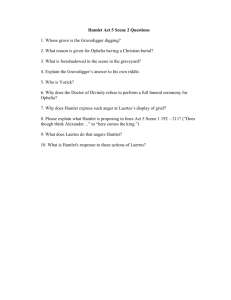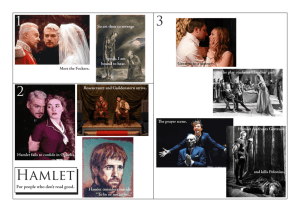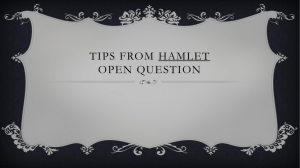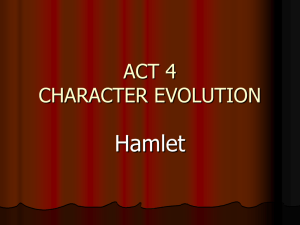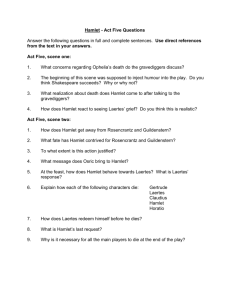Grade 11 ELA Module 1, Unit 2, Lesson 22
advertisement
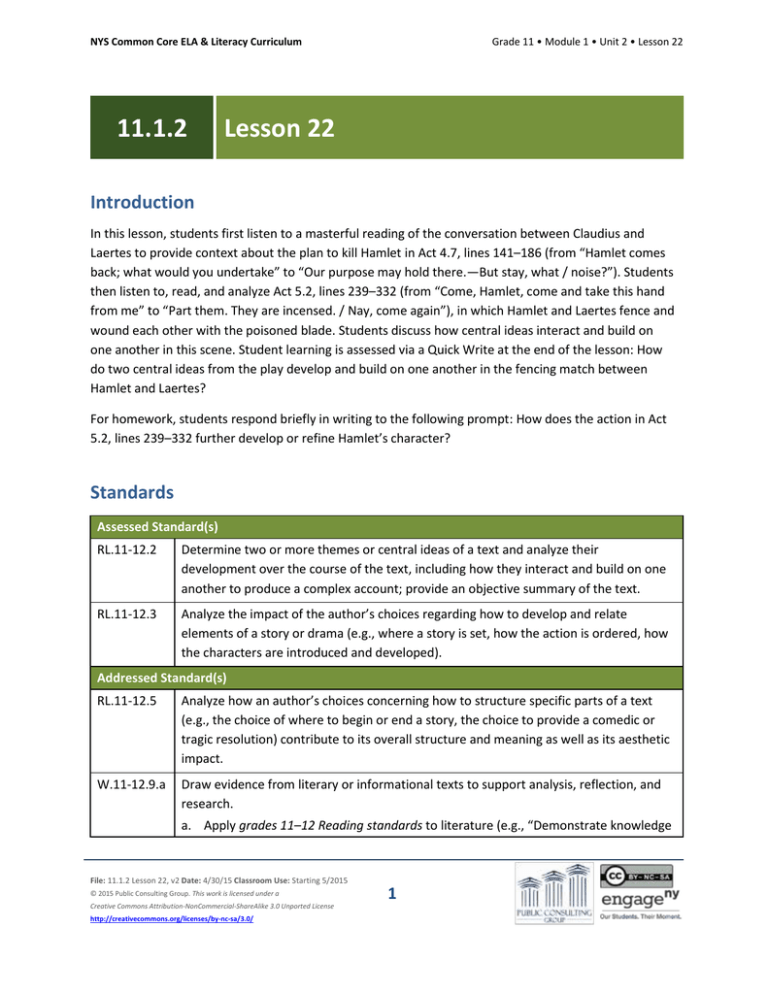
NYS Common Core ELA & Literacy Curriculum 11.1.2 Grade 11 • Module 1 • Unit 2 • Lesson 22 Lesson 22 Introduction In this lesson, students first listen to a masterful reading of the conversation between Claudius and Laertes to provide context about the plan to kill Hamlet in Act 4.7, lines 141–186 (from “Hamlet comes back; what would you undertake” to “Our purpose may hold there.—But stay, what / noise?”). Students then listen to, read, and analyze Act 5.2, lines 239–332 (from “Come, Hamlet, come and take this hand from me” to “Part them. They are incensed. / Nay, come again”), in which Hamlet and Laertes fence and wound each other with the poisoned blade. Students discuss how central ideas interact and build on one another in this scene. Student learning is assessed via a Quick Write at the end of the lesson: How do two central ideas from the play develop and build on one another in the fencing match between Hamlet and Laertes? For homework, students respond briefly in writing to the following prompt: How does the action in Act 5.2, lines 239–332 further develop or refine Hamlet’s character? Standards Assessed Standard(s) RL.11-12.2 Determine two or more themes or central ideas of a text and analyze their development over the course of the text, including how they interact and build on one another to produce a complex account; provide an objective summary of the text. RL.11-12.3 Analyze the impact of the author’s choices regarding how to develop and relate elements of a story or drama (e.g., where a story is set, how the action is ordered, how the characters are introduced and developed). Addressed Standard(s) RL.11-12.5 Analyze how an author’s choices concerning how to structure specific parts of a text (e.g., the choice of where to begin or end a story, the choice to provide a comedic or tragic resolution) contribute to its overall structure and meaning as well as its aesthetic impact. W.11-12.9.a Draw evidence from literary or informational texts to support analysis, reflection, and research. a. Apply grades 11–12 Reading standards to literature (e.g., “Demonstrate knowledge File: 11.1.2 Lesson 22, v2 Date: 4/30/15 Classroom Use: Starting 5/2015 © 2015 Public Consulting Group. This work is licensed under a Creative Commons Attribution-NonCommercial-ShareAlike 3.0 Unported License http://creativecommons.org/licenses/by-nc-sa/3.0/ 1 NYS Common Core ELA & Literacy Curriculum Grade 11 • Module 1 • Unit 2 • Lesson 22 of eighteenth-, nineteenth- and early-twentieth-century foundational works of American literature, including how two or more texts from the same period treat similar themes or topics”). L.11-12.4.c Determine or clarify the meaning of unknown and multiple-meaning words and phrases based on grades 11–12 reading and content, choosing flexibly from a range of strategies. c. Consult general and specialized reference materials (e.g., dictionaries, glossaries, thesauruses), both print and digital, to find the pronunciation of a word or determine or clarify its precise meaning, its part of speech, its etymology, or its standard usage. Assessment Assessment(s) Student learning is assessed via a Quick Write at the end of the lesson. Students respond to the following prompt, citing textual evidence to support analysis and inferences drawn from the text. How do two central ideas from the play develop and build on one another in the fencing match between Hamlet and Laertes? High Performance Response(s) A High Performance Response should: Identify two central ideas that develop in the fencing match (e.g., madness, mortality, revenge, action vs. inaction). Analyze how the two identified central ideas build on one another (e.g., During the fencing match, Claudius and Laertes intend to kill Hamlet with the poisoned blade or the poisoned cup. While making their plans to kill Hamlet, Laertes says, “I’ll anoint my sword” with poison (Act 4.7, line 160), and Claudius says, “I’ll have prepared / him / A chalice for the nonce” or poison (Act 4.7, lines 181–183). However, similar to Hamlet’s earlier accidental killing of Polonius, other characters die unintentionally. The deaths of the Queen, who drinks the poisoned cup intended for Hamlet (Act 5.2, line 318.1), and Laertes, who is wounded by the poisoned blade intended for Hamlet (Act 5.2, line 330.1), illustrate the interaction of the central ideas of mortality and revenge. Laertes believes he can avenge Ophelia and Polonius’s deaths by killing Hamlet, but Laertes’s attempt at revenge leads to two more deaths, further developing the idea that death is inevitable but unpredictable.). File: 11.1.2 Lesson 22, v2 Date: 4/30/15 Classroom Use: Starting 5/2015 © 2015 Public Consulting Group. This work is licensed under a Creative Commons Attribution-NonCommercial-ShareAlike 3.0 Unported License http://creativecommons.org/licenses/by-nc-sa/3.0/ 2 NYS Common Core ELA & Literacy Curriculum Grade 11 • Module 1 • Unit 2 • Lesson 22 Vocabulary Vocabulary to provide directly (will not include extended instruction) palpable (adj.) – capable of being touched or felt; tangible Vocabulary to teach (may include direct word work and/or questions) sore (adj.) – severe; grave foils (n.) – blunted weapons Additional vocabulary to support English Language Learners (to provide directly) aloof (adj.) – not involved in or influenced by something wager (n.) – the money or other valuable thing that you could win or lose in a bet mock (v.) – to laugh at or make fun of (someone or something) Lesson Agenda/Overview Student-Facing Agenda % of Lesson Standards & Text: Standards: RL.11-12.2, RL.11-12.3, RL.11-12.5, W.11-12.9.a, L.11-12.4.c Text: Hamlet by William Shakespeare, Act 5.2: lines 239–332 (Masterful Reading: Act 4.7: lines 141–186 and Act 5.2: lines 239–332) In order to provide additional context, the masterful reading extends beyond the lines students read and discuss during the lesson. Learning Sequence: 1. 2. 3. 4. 5. 6. Introduction of Lesson Agenda Homework Accountability Masterful Reading Reading and Discussion Quick Write Closing 1. 2. 3. 4. 5. 6. 10% 15% 15% 45% 10% 5% Materials Student copies of the 11.1 Common Core Learning Standards Tool (refer to 11.1.1 Lesson 1) File: 11.1.2 Lesson 22, v2 Date: 4/30/15 Classroom Use: Starting 5/2015 © 2015 Public Consulting Group. This work is licensed under a Creative Commons Attribution-NonCommercial-ShareAlike 3.0 Unported License http://creativecommons.org/licenses/by-nc-sa/3.0/ 3 NYS Common Core ELA & Literacy Curriculum Grade 11 • Module 1 • Unit 2 • Lesson 22 Student copies of the Central Ideas Tracking Tool (refer to 11.1.2 Lesson 7)—students may need additional blank copies Student copies of the Short Response Rubric and Checklist (refer to 11.1.1 Lesson 1) Learning Sequence How to Use the Learning Sequence Symbol Type of Text & Interpretation of the Symbol 10% Percentage indicates the percentage of lesson time each activity should take. Plain text indicates teacher action. Bold text indicates text dependent questions. Italicized text indicates a vocabulary word. Indicates student action(s). Indicates possible student response(s) to teacher questions. Indicates instructional notes for the teacher. no symbol Activity 1: Introduction of Lesson Agenda 10% Begin by reviewing the agenda and the assessed standards for this lesson: RL.11-2.2 and RL.11-12.3. In this lesson, students analyze how central ideas interact and build on one another at the end of Hamlet. Students look at the agenda. Students also work with a new element of standard RL.11-12.5. Ask student pairs to consider the term tragic resolution and propose their own definition of the term using the definitions of the individual words to help them define the phrase. Student responses may include: o o o A tragic resolution is a sad ending. A tragic resolution means people die at the end. A tragic resolution means that a problem is solved but not happily. Provide students with the following definition: tragic resolution means “an event or series of events that involves a reversal of fortune and the resolution of previously unresolved conflicts.” Ask students to annotate RL.11-12.5 on their Common Core Learning Standards Tool with this definition. Remind students that the full title of Hamlet is The Tragedy of Hamlet, Prince of Denmark. Students read and annotate standard RL.11-12.5 on their 11.1 Common Core Learning Standards Tool with the definition of tragic resolution. File: 11.1.2 Lesson 22, v2 Date: 4/30/15 Classroom Use: Starting 5/2015 © 2015 Public Consulting Group. This work is licensed under a Creative Commons Attribution-NonCommercial-ShareAlike 3.0 Unported License http://creativecommons.org/licenses/by-nc-sa/3.0/ 4 NYS Common Core ELA & Literacy Curriculum Grade 11 • Module 1 • Unit 2 • Lesson 22 Activity 2: Homework Accountability 15% Instruct students to talk in pairs about how they applied focus standard RL.11-12.5 or RI.11-12.5 to their Accountable Independent Reading (AIR) texts. Lead a brief share out on the previous lesson’s AIR homework assignment. Select several students (or student pairs) to explain how they applied focus standard RL.11-12.5 or RI.11-12.5 to their AIR texts. Students (or student pairs) discuss and share how they applied the focus standard to their AIR texts from the previous lesson’s homework. Instruct students to take out their responses to the previous lesson’s homework assignment. (Reread “My Last Duchess” and write a short paragraph (3–5 sentences) explaining how the setting of the poem is important to other elements of the text.) Instruct students to form pairs to share their homework responses. Student responses may include: o o o o Being in his own house allows the Duke to show off the portrait of his “last Duchess” (line 1), as well as “Neptune … / Taming a sea-horse” (lines 54–56). The setting provides an occasion for the Duke to talk about his objects. Because the poem is set in the Duke’s house, the Duke is in control of what to show his visitor: “none puts by / The curtain I have drawn for you” (lines 9–10). He also decides where to take the visitor: “Will ’t please you rise? We’ll meet / The company below then” (lines 47–48). Because the Duke and the listener are alone upstairs while the listener’s “master” and his daughter are absent, the Duke can say things to the listener that he may or may not say to his master and the master’s daughter. For example, he admits to murdering or silencing his former wife: “I gave commands; / Then all smiles stopped together” (lines 45–46). Activity 3: Masterful Reading 15% This lesson includes excerpts from Acts 4 and 5 and includes a separate masterful reading of each excerpt. Inform students that the first masterful reading is of a conversation between Laertes and Claudius that reveals a plan leading up to the final scene of the play. Remind students that Ophelia’s funeral took place in Act 5.1. The conversation students are about to hear between Laertes and Claudius is from Act 4.7, prior to Ophelia’s funeral. File: 11.1.2 Lesson 22, v2 Date: 4/30/15 Classroom Use: Starting 5/2015 © 2015 Public Consulting Group. This work is licensed under a Creative Commons Attribution-NonCommercial-ShareAlike 3.0 Unported License http://creativecommons.org/licenses/by-nc-sa/3.0/ 5 NYS Common Core ELA & Literacy Curriculum Grade 11 • Module 1 • Unit 2 • Lesson 22 Differentiation Consideration: Consider posting or projecting the following guiding question to support students in their reading throughout this lesson: How successful is Laertes’s and Claudius’s plan in the final scene? Have students listen to a masterful reading of Act 4.7, lines 141–186 (from “Hamlet comes back; what would you undertake” to “Our purpose may hold there.—But stay, what / noise?”). Ask students to focus on Laertes’s and Claudius’s plan and their motivation behind the plan. Students follow along, reading silently. Instruct student pairs to share their understanding of the plan and Laertes’s and Claudius’s motivations. Then invite two or three pairs to share out their responses with the class. Laertes will fence with Hamlet and wound him with a poisoned blade. If Laertes is unable to wound Hamlet, Claudius will offer him a cup of poisoned wine at a break during the fencing match. Laertes and Claudius say they are motivated by revenge because Hamlet killed Polonius. Have students listen to a masterful reading of Act 5.2, lines 239–332 (from “Come, Hamlet, come and take this hand” to “Part them. They are incensed. / Nay, come again”). Ask students to focus on how Laertes’s and Claudius’s plan unfolds. Students follow along, reading silently. Activity 4: Reading and Discussion 45% Instruct students to form pairs. Post or project each set of questions below for students to discuss. Instruct students to continue to annotate the text and focus on the development of central ideas as they read and discuss. Consider drawing students’ attention to their application of standard W.11-12.9.a through the process of annotating for central ideas. Instruct student pairs to read Act 5.2, lines 240–276 (from “Give me your pardon, sir. I have done you wrong” to “You mock me, sir. / No, by this hand”) and answer the following questions before sharing out with the class. Differentiation Consideration: Consider providing students with the following definitions: aloof means “not involved in or influenced by something” and wager means “the money or other valuable thing you could win or lose in a bet.” File: 11.1.2 Lesson 22, v2 Date: 4/30/15 Classroom Use: Starting 5/2015 © 2015 Public Consulting Group. This work is licensed under a Creative Commons Attribution-NonCommercial-ShareAlike 3.0 Unported License http://creativecommons.org/licenses/by-nc-sa/3.0/ 6 NYS Common Core ELA & Literacy Curriculum Grade 11 • Module 1 • Unit 2 • Lesson 22 Students write the definitions of aloof and wager on their copies of the text or in a vocabulary journal. Direct students to the explanatory notes for definitions of the following words: sore and foils. Consider drawing students’ attention to their application of standard L.11-12.4.c through the process of using the explanatory notes to make meaning of a word. What is the “sore distraction” to which Hamlet refers in line 244? Hamlet uses the term “sore distraction” to refer to his madness. What is the meaning of Hamlet’s question, “Was ’t Hamlet wronged Laertes? Never Hamlet” (line 247)? Hamlet claims he was not responsible for hurting Laertes because he was mad. What is the effect of Hamlet referring to himself in the third person in lines 247–253? Student responses may include: o o Hamlet seems less guilty for the murder of Polonius when he refers to himself in the third person. When he shifts from the first person to the third person, Hamlet seems mad and may be using the madness to try to gain Laertes’s forgiveness. How does Laertes respond to Hamlet’s request for forgiveness (lines 259–267)? Laertes says that he is “satisfied in nature” (line 259), or in terms of his feelings, by Hamlet’s request for forgiveness, but he cannot forgive Hamlet until “some elder masters” (line 263) advise him about whether his “honor” (line 261) and “name” are “ungored” (line 265). In other words, he cannot fully forgive Hamlet until he knows that his honor will be safe. How does this exchange between Hamlet and Laertes further develop two central ideas introduced earlier in the play? Student responses may include: o The exchange between Hamlet and Laertes further develops the central idea of madness, as the audience is left to wonder whether throughout the play Hamlet was mad or was only pretending to be so. Hamlet claims madness as his reason for offending Laertes when he says, “I here proclaim was madness” (line 246), but it is unclear whether Hamlet is using madness as an excuse or if he was truly mad and is now sane enough to understand his madness. File: 11.1.2 Lesson 22, v2 Date: 4/30/15 Classroom Use: Starting 5/2015 © 2015 Public Consulting Group. This work is licensed under a Creative Commons Attribution-NonCommercial-ShareAlike 3.0 Unported License http://creativecommons.org/licenses/by-nc-sa/3.0/ 7 NYS Common Core ELA & Literacy Curriculum o Grade 11 • Module 1 • Unit 2 • Lesson 22 The exchange between Hamlet and Laertes further develops the central idea of revenge, as Laertes demonstrates what Hamlet has not been able to throughout the play: revenge for a wrongfully murdered father. Like Hamlet, Laertes considers all aspects of his revenge and admits that his feelings for his loved ones “stir [him] most / to [his] revenge” (lines 260– 261), and those are now satisfied by Hamlet’s apology and explanation of his madness. However, “in [his] terms of honor” (line 261), he is not satisfied, so he must fight Hamlet in order “to keep [his] name ungored” (line 265), in other words, to honor his family. What are the different meanings of foil as it is used in line 272? Hamlet uses the pun, “I’ll be your foil, Laertes” in line 272. Foil has three different meanings that apply in this scene. First, Hamlet is referring to the blunted or unsharpened fencing swords called foils. Second, Hamlet means that Laertes will look like a good fencer compared to Hamlet’s lesser fencing skills. Third, foil describes a character in literature that is similar to the main character in some ways but contrasts with the main character in an important way; Laertes is a foil to Hamlet. Differentiation Consideration: If students struggle with this question, consider reminding them of their work with literary foils in 11.1.2 Lesson 18. The word pun is used in the explanatory notes, and multiple puns appear throughout Hamlet. If students do not understand the meaning of pun, consider defining it as a “joke based on a word or phrase with more than one meaning.” Lead a brief whole-class discussion of student responses. Instruct students to read lines 277–332 (from “Give them the foils, young Osric. Cousin Hamlet” to “Part them. They are incensed. / Nay, come again”). Provide students with the following definition: palpable means “capable of being touched or felt; tangible.” Students may be familiar with this word. Consider asking students to volunteer a definition before providing one to the group. Students write the definition of palpable on their copies of the text or in a vocabulary journal. Differentiation Consideration: Consider providing students with the following definition: mock means “to laugh at or make fun of (someone or something).” Students write the definition of mock on their copies of the text or in a vocabulary journal. File: 11.1.2 Lesson 22, v2 Date: 4/30/15 Classroom Use: Starting 5/2015 © 2015 Public Consulting Group. This work is licensed under a Creative Commons Attribution-NonCommercial-ShareAlike 3.0 Unported License http://creativecommons.org/licenses/by-nc-sa/3.0/ 8 NYS Common Core ELA & Literacy Curriculum Grade 11 • Module 1 • Unit 2 • Lesson 22 Instruct student pairs to summarize what happens when Claudius offers Hamlet a drink on line 306 and when Hamlet refuses the drink on line 320. Remind students to consider the stage directions and how they relate to what the characters say. Students work in pairs to write a brief summary of the events in lines 306–320. Claudius offers Hamlet a drink but Hamlet refuses it. Hamlet hits Laertes for a second point in the match, and then the Queen takes a drink from the poisoned cup. Claudius tries to stop Gertrude from drinking, but she does it anyway. Claudius reveals that Gertrude will die, and then Hamlet refuses a second time to drink from the cup. Ask for student volunteers to share their written summaries. Instruct student pairs to answer the following questions before sharing out with the class. Why does Laertes say, “it is almost against my conscience” (line 324)? What does this suggest about the relationship between conscience and revenge? Student responses may include: o o Laertes is questioning his plan to kill Hamlet with the poisoned rapier. This statement suggests revenge can overpower conscience. Laertes reveals an inner struggle about whether or not he should follow through with his plan, but the word almost indicates that Laertes will continue with his plan. Laertes is questioning his plan to kill Hamlet with the poisoned rapier. This statement suggests that conscience can oppose a character’s desire to seek revenge. What happens during the fencing match immediately following line 330? What does this suggest will happen to Hamlet and Laertes later in the scene? Hamlet and Laertes struggle, exchange rapiers, and wound each other: “Laertes wounds Hamlet. Then in scuffling they change / rapiers, and Hamlet wounds Laertes” (line 330.1). This means both Hamlet and Laertes will die soon, as a result of the fencing match. Remind students to use the Central Ideas Tracking Tool to record central ideas they identify and discuss. Encourage students to record related concepts in the right-hand column of the tool, noting how these concepts support the development of larger central ideas. Related concepts that arise in this lesson include fate, family duty, and morality. Lead a brief whole-class discussion of student responses. File: 11.1.2 Lesson 22, v2 Date: 4/30/15 Classroom Use: Starting 5/2015 © 2015 Public Consulting Group. This work is licensed under a Creative Commons Attribution-NonCommercial-ShareAlike 3.0 Unported License http://creativecommons.org/licenses/by-nc-sa/3.0/ 9 NYS Common Core ELA & Literacy Curriculum Grade 11 • Module 1 • Unit 2 • Lesson 22 Activity 5: Quick Write 10% Instruct students to respond briefly in writing to the following prompt: How do two central ideas from the play develop and build on one another in the fencing match between Hamlet and Laertes? Ask students to use this lesson’s vocabulary wherever possible in their written responses. Remind students to use the Short Response Rubric and Checklist to guide their written responses. Students listen and read the Quick Write prompt. Display the prompt for students to see, or provide the prompt in hard copy. Transition to the independent Quick Write. Students independently answer the prompt using evidence from the text. See the High Performance Response at the beginning of this lesson. Activity 6: Closing 5% Display and distribute the homework assignment. For homework, instruct students to reread Act 5.2, lines 239–332 (from “Come, Hamlet, come and take this hand from me” to “Part them. They are incensed. / Nay, come again”). Then instruct students to respond briefly in writing to the following prompt: How does the action in Act 5.2, lines 239–332 further develop or refine Hamlet’s character? Ask students to use this lesson’s vocabulary wherever possible in their written responses. Remind students to use the Short Response Rubric and Checklist to guide their written responses. Students follow along. Homework Reread Act 5.2, lines 239–332 (from “Come, Hamlet, come and take this hand from me” to “Part them. They are incensed. / Nay, come again”) and respond briefly in writing to the following prompt: How does the action in Act 5.2, lines 239–332 further develop or refine Hamlet’s character? Use this lesson’s vocabulary wherever possible in your written response. Remember to use the Short Response Rubric and Checklist to guide your written response. File: 11.1.2 Lesson 22, v2 Date: 4/30/15 Classroom Use: Starting 5/2015 © 2015 Public Consulting Group. This work is licensed under a Creative Commons Attribution-NonCommercial-ShareAlike 3.0 Unported License http://creativecommons.org/licenses/by-nc-sa/3.0/ 10 NYS Common Core ELA & Literacy Curriculum Grade 11 • Module 1 • Unit 2 • Lesson 22 Model Central Ideas Tracking Tool Name: Class: Date: Directions: As you read, record evidence of central ideas as well as explanations of how the evidence is connected and/or demonstrates the development of the central ideas in the text. Text: Hamlet by William Shakespeare Act/Scene/ Line # Central Ideas Evidence, Connections, and Development Act 5.2, lines 318–330 Mortality The deaths of the Queen, who drinks the poisoned cup intended for Hamlet (line 318.1), and Laertes, who is wounded by the poisoned blade intended for Hamlet (line 330.1), illustrate the central idea of mortality: death is inevitable but unpredictable. Act 5.2, lines 260–265 Revenge Laertes says his feelings for his loved ones “stir [him] most / to [his] revenge” (lines 260–261), demonstrating that revenge motivates him more than “honor” (line 261) or his “name” (line 265). Act 5.2, lines 246–253 Madness Hamlet claims he was not responsible for hurting Laertes because he was mad: “What I have done / That might your nature, honor, and exception / Roughly awake, I here proclaim was madness” (lines 244–246). Hamlet refers to himself in the third person to seem more mad: “His madness is poor Hamlet’s enemy” (line 253). Act 5.2, lines 318–330 Action vs. inaction By fighting Laertes, Hamlet finally moves from inaction to action. File: 11.1.2 Lesson 22, v2 Date: 4/30/15 Classroom Use: Starting 5/2015 © 2015 Public Consulting Group. This work is licensed under a Creative Commons Attribution-NonCommercial-ShareAlike 3.0 Unported License http://creativecommons.org/licenses/by-nc-sa/3.0/ 11
